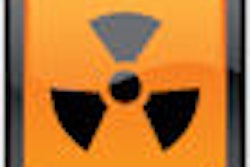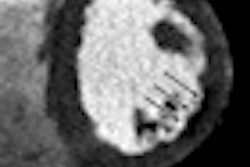FDG-PET/CT is not only most effective for pretreatment screening of distant metastases in patients with head and neck squamous cell carcinoma, the combined modalities do so with no additional costs to healthcare providers, according to researchers in the Netherlands.
The study, published in the February issue of the Journal of Nuclear Medicine, found that FDG-PET/CT had greater sensitivity than FDG-PET and CT alone and resulted in average total savings of between $303 and $903 on a per-patient basis (JNM, Vol. 51:2, pp. 176-182).
The prospective, multicenter trial was based at the University Medical Center Rotterdam and VU University Medical Center in Amsterdam, with Dr. Carin Uyl-de Groot as the lead study author.
Researchers initially enrolled 145 consecutive patients with head and neck squamous cell carcinoma who were candidates for extensive treatment, such as surgery or radiation therapy.
Scanning protocols
All patients received a spiral CT chest scan (Somatom Plus, Siemens Healthcare, Erlangen, Germany) with intravenous contrast (Ultravist, Bayer Schering Pharma, Berlin). They also received an FDG-PET scan from the knee to the base of the skull (ECAT HR1, Siemens Healthcare) 60 to 90 minutes after receiving 250 to 370 MBq of FDG.
The researchers were able to collect complete data on 80 patients for their cost and follow-up treatment analyses. Of the 80 patients, there were 63 men and 17 women, with a mean age of 60 years, ranging from 40 to 81 years. The cost analysis included the sensitivity findings for the FDG-PET/CT scans and FDG-PET and CT scans performed independently.
Pretreatment screening identified distant metastases in 17 patients (21%) and second primary tumors in six patients (8%). All patients with distant metastases were treated palliatively. Half of the patients with a second primary tumor had lung or brain metastases and also received palliative treatment. Three others had limited-stage disease of their secondary primary tumor and received curative treatment for both primary tumors.
The researchers found that FDG-PET/CT exhibited the greatest sensitivity, followed by FDG-PET and CT alone:
- FDG-PET/CT -- 63%
- FDG-PET -- 53%
- CT -- 37%
FDG-PET also recorded greater positive predictive value than CT, at 80% versus 75%, respectively.
Patient follow-up was performed every six weeks during the first year of the study, during which the dates of when distant metastases and second primary tumors were detected were recorded. The researchers also noted if and when any patients died during that time.
In patient follow-up, the researchers detected distant metastasis in 26 (33%) of the 80 patients, while a second primary tumor was found in seven patients (9%) during screening or within the 12 months of follow-up.
In reviewing the costs of patients' curative or palliative treatment, the researchers considered direct expenses for diagnosis and treatment, including radiation therapy, surgery, and imaging scans, as well as services that are not directly allocated to patient care, such as hospital overhead and administrative personnel.
When patients received curative treatment, the diagnostic strategy that resulted from FDG-PET/CT scans was less expensive than both CT and FDG-PET alone.
Total overall costs for FDG-PET/CT also were less -- 37,954 euros ($56,741 U.S.), compared with 38,355 euros ($57,341 U.S.) for FDG-PET and 38,558 euros ($57,644 U.S.) for CT.
Average costs
|
||||||||||||||||||||||||||||||||||||
| Source: Journal of Nuclear Medicine. | ||||||||||||||||||||||||||||||||||||
While the "differences between these scenarios are small," the authors concluded, "the introduction of FDG-PET led to a cost reduction between 203 euros ($303) and 604 euros ($903)."
The researchers also found that the better results from FDG-PET/CT scans offset additional diagnostic costs from FDG-PET imaging.
The most significant cost differences between the modalities were in the number of days patients spent in the hospital, as well as costs of surgery and radiation therapy. "These changes are caused by the reduction of futile operations and curative radiotherapy in both the FDG-PET and the FDG-PET/CT scenarios versus the CT scenario," the group wrote.
Curative treatment
|
||||||||||||||||||||||||||||||||||||
| Source: Journal of Nuclear Medicine. | ||||||||||||||||||||||||||||||||||||
Uyl-de Groot and colleagues noted that their results may vary in other countries, as healthcare policies and prices differ. "However, the outcomes of this study mainly depend on the sensitivity and specificity of FDG-PET/CT and the costs of FDG-PET/CT," they wrote. "Especially the prices of FDG-PET and hospital days could differ between countries. In general, these cost prices are higher in other countries, especially in the U.S."
By Wayne Forrest
AuntMinnie.com staff writer
February 17, 2010
Related Reading
PET scan can increase accuracy of head/neck cancer staging, February 11, 2010
Early FDG-PET/CT may help head and neck cancer therapy, November 20, 2009
Fluoride ion FDG-PET/CT beats FDG for metastatic spinal bone lesions, November 3, 2009
FDG-PET/CT scans spot head and neck cancer return October 14, 2009
FDG-PET/CT helps track pediatric bone and soft-tissue tumors, June 16, 2009
Copyright © 2010 AuntMinnie.com



















